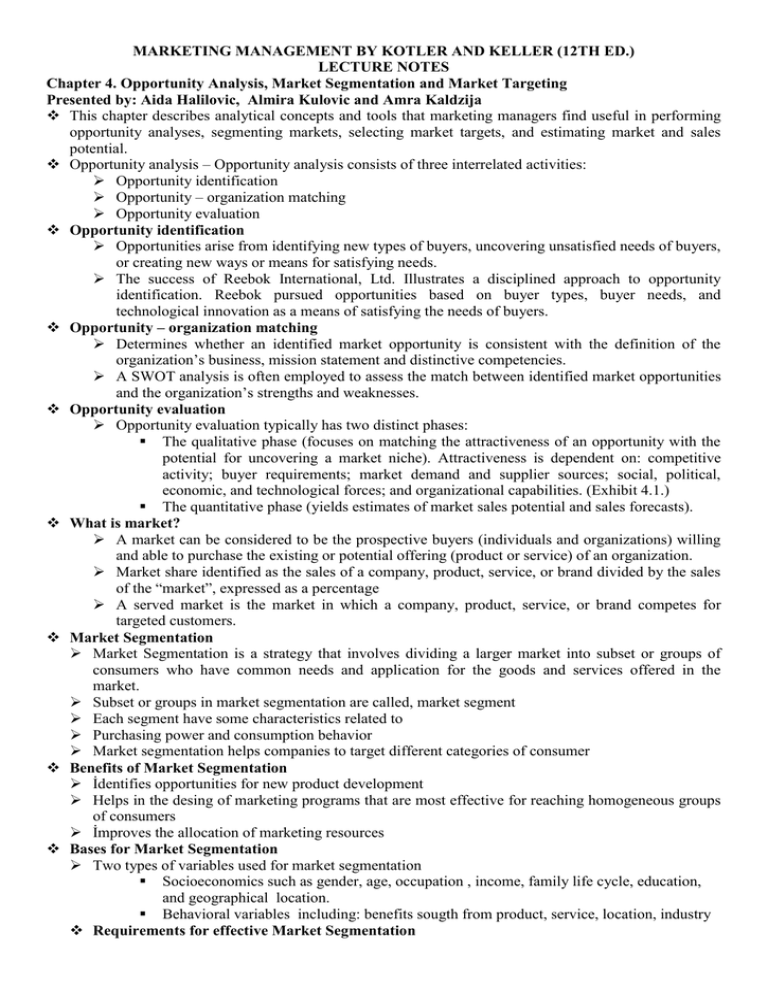MARKETING MANAGEMENT BY KOTLER AND KELLER (12TH ED
advertisement

MARKETING MANAGEMENT BY KOTLER AND KELLER (12TH ED.) LECTURE NOTES Chapter 4. Opportunity Analysis, Market Segmentation and Market Targeting Presented by: Aida Halilovic, Almira Kulovic and Amra Kaldzija This chapter describes analytical concepts and tools that marketing managers find useful in performing opportunity analyses, segmenting markets, selecting market targets, and estimating market and sales potential. Opportunity analysis – Opportunity analysis consists of three interrelated activities: Opportunity identification Opportunity – organization matching Opportunity evaluation Opportunity identification Opportunities arise from identifying new types of buyers, uncovering unsatisfied needs of buyers, or creating new ways or means for satisfying needs. The success of Reebok International, Ltd. Illustrates a disciplined approach to opportunity identification. Reebok pursued opportunities based on buyer types, buyer needs, and technological innovation as a means of satisfying the needs of buyers. Opportunity – organization matching Determines whether an identified market opportunity is consistent with the definition of the organization’s business, mission statement and distinctive competencies. A SWOT analysis is often employed to assess the match between identified market opportunities and the organization’s strengths and weaknesses. Opportunity evaluation Opportunity evaluation typically has two distinct phases: The qualitative phase (focuses on matching the attractiveness of an opportunity with the potential for uncovering a market niche). Attractiveness is dependent on: competitive activity; buyer requirements; market demand and supplier sources; social, political, economic, and technological forces; and organizational capabilities. (Exhibit 4.1.) The quantitative phase (yields estimates of market sales potential and sales forecasts). What is market? A market can be considered to be the prospective buyers (individuals and organizations) willing and able to purchase the existing or potential offering (product or service) of an organization. Market share identified as the sales of a company, product, service, or brand divided by the sales of the “market”, expressed as a percentage A served market is the market in which a company, product, service, or brand competes for targeted customers. Market Segmentation Market Segmentation is a strategy that involves dividing a larger market into subset or groups of consumers who have common needs and application for the goods and services offered in the market. Subset or groups in market segmentation are called, market segment Each segment have some characteristics related to Purchasing power and consumption behavior Market segmentation helps companies to target different categories of consumer Benefits of Market Segmentation İdentifies opportunities for new product development Helps in the desing of marketing programs that are most effective for reaching homogeneous groups of consumers İmproves the allocation of marketing resources Bases for Market Segmentation Two types of variables used for market segmentation Socioeconomics such as gender, age, occupation , income, family life cycle, education, and geographical location. Behavioral variables including: benefits sougth from product, service, location, industry Requirements for effective Market Segmentation To identify and profile distnct groups of buyers who differ in their needs Effective market segmentation should provide answer on six fundamental buyer – related questions 1. Who are they? 2. What do they want to buy? 3. How do they want to buy? 4. When do they want to buy? 5. Where do they want to buy? 6. Why do they want to buy? From managerial perspecitve effective market segmentation satisfies four fundamental requirements 1. Measurable 2. Differentiable 3. Accessible 4. Substantial Market Targeting Market Targeting – specification of the market segments the organization wishes to pursue. Three questions that need to be adressed after a market has been segmented: Where to compete? How to compete? When to compete? 1. Where to compete? Question focuses on which market segments the company should choose to make marketing efforts, or market targeting. 2. How to compete? Question focuses how many segments the organization will pursue and what marketing strategies will be employed. Two frequently used market targeting approaches: Differentiated marketing approach Concentrated marketing approach Differentiated marketing approach – the company pursues several different marke segments, but with a unique marketing strategy for each. This approach is very expensive to implement. Concentrated marketing approach – the organization focuses on a single market segment, or more commonly an organization offers one or more product lines to a single segment. This approach is very helpful in gaining a strong knowledge about the segment's needs and helps a company to achieve a strong market position 3. When to compete? 4. Question focuses on timing and some organizations adopt a first-to-market posture, while others take a wait-and-see stance concerning the pursuti of market segments. Timing can have a significant effect on sales and profit.





